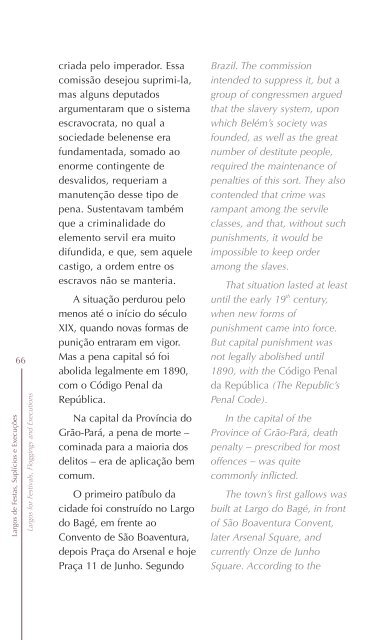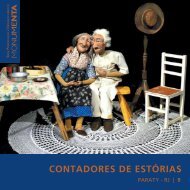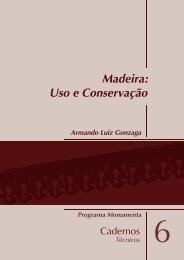LARGOS, CORETOS E PRAÇAS DE BELÉM - Monumenta
LARGOS, CORETOS E PRAÇAS DE BELÉM - Monumenta
LARGOS, CORETOS E PRAÇAS DE BELÉM - Monumenta
Create successful ePaper yourself
Turn your PDF publications into a flip-book with our unique Google optimized e-Paper software.
Largos de Festas, Suplícios e Execuções<br />
66<br />
Largos for Festivals, Floggings and Executions<br />
criada pelo imperador. Essa<br />
comissão desejou suprimi-la,<br />
mas alguns deputados<br />
argumentaram que o sistema<br />
escravocrata, no qual a<br />
sociedade belenense era<br />
fundamentada, somado ao<br />
enorme contingente de<br />
desvalidos, requeriam a<br />
manutenção desse tipo de<br />
pena. Sustentavam também<br />
que a criminalidade do<br />
elemento servil era muito<br />
difundida, e que, sem aquele<br />
castigo, a ordem entre os<br />
escravos não se manteria.<br />
A situação perdurou pelo<br />
menos até o início do século<br />
XIX, quando novas formas de<br />
punição entraram em vigor.<br />
Mas a pena capital só foi<br />
abolida legalmente em 1890,<br />
com o Código Penal da<br />
República.<br />
Na capital da Província do<br />
Grão-Pará, a pena de morte –<br />
cominada para a maioria dos<br />
delitos – era de aplicação bem<br />
comum.<br />
O primeiro patíbulo da<br />
cidade foi construído no Largo<br />
do Bagé, em frente ao<br />
Convento de São Boaventura,<br />
depois Praça do Arsenal e hoje<br />
Praça 11 de Junho. Segundo<br />
Brazil. The commission<br />
intended to suppress it, but a<br />
group of congressmen argued<br />
that the slavery system, upon<br />
which Belém’s society was<br />
founded, as well as the great<br />
number of destitute people,<br />
required the maintenance of<br />
penalties of this sort. They also<br />
contended that crime was<br />
rampant among the servile<br />
classes, and that, without such<br />
punishments, it would be<br />
impossible to keep order<br />
among the slaves.<br />
That situation lasted at least<br />
until the early 19 th century,<br />
when new forms of<br />
punishment came into force.<br />
But capital punishment was<br />
not legally abolished until<br />
1890, with the Código Penal<br />
da República (The Republic’s<br />
Penal Code).<br />
In the capital of the<br />
Province of Grão-Pará, death<br />
penalty – prescribed for most<br />
offences – was quite<br />
commonly inflicted.<br />
The town’s first gallows was<br />
built at Largo do Bagé, in front<br />
of São Boaventura Convent,<br />
later Arsenal Square, and<br />
currently Onze de Junho<br />
Square. According to the













